BSc Business Management: Cross-Cultural Management Reflective Report
VerifiedAdded on 2023/01/10
|9
|2981
|25
Report
AI Summary
This reflective report delves into a case study involving Brett Jones and a dam project in Tanzania, examining the challenges of cross-cultural management. The report explores the impact of organizational structure, communication, and leadership on project outcomes. It highlights issues such as high employee turnover and opposition from local tribes, analyzing Jones's management practices within the context of cross-cultural dynamics. The analysis incorporates relevant theories, such as Hofstede's cultural dimensions, to understand and address the problems faced. Recommendations include adopting hierarchical organizational structures, ethical recruitment practices, and effective communication strategies to improve project success and mitigate cultural conflicts. The report emphasizes the importance of understanding and adapting to cultural differences in international projects to foster better employee relations and community support.

Reflective Report
Paraphrase This Document
Need a fresh take? Get an instant paraphrase of this document with our AI Paraphraser
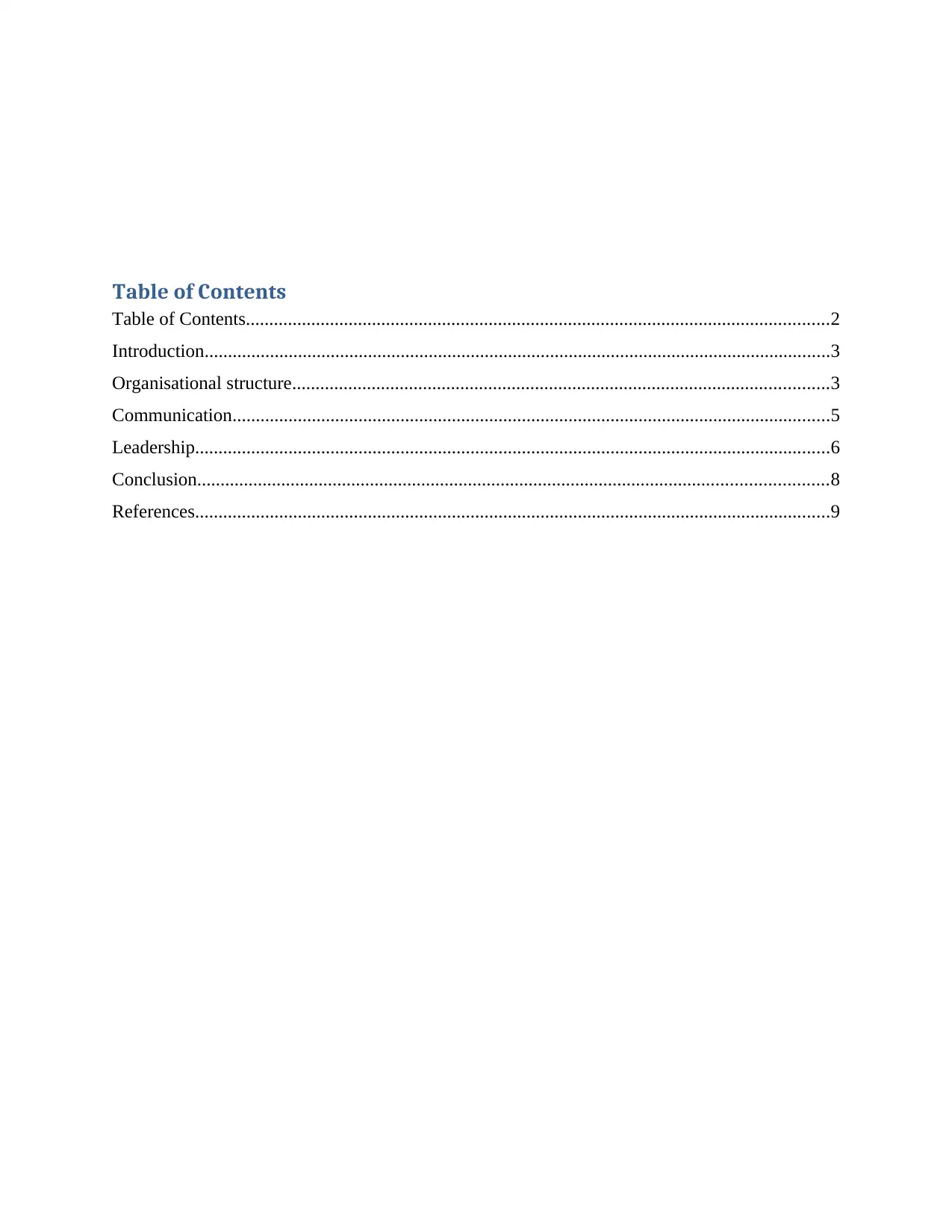
Table of Contents
Table of Contents.............................................................................................................................2
Introduction......................................................................................................................................3
Organisational structure...................................................................................................................3
Communication................................................................................................................................5
Leadership........................................................................................................................................6
Conclusion.......................................................................................................................................8
References........................................................................................................................................9
Table of Contents.............................................................................................................................2
Introduction......................................................................................................................................3
Organisational structure...................................................................................................................3
Communication................................................................................................................................5
Leadership........................................................................................................................................6
Conclusion.......................................................................................................................................8
References........................................................................................................................................9
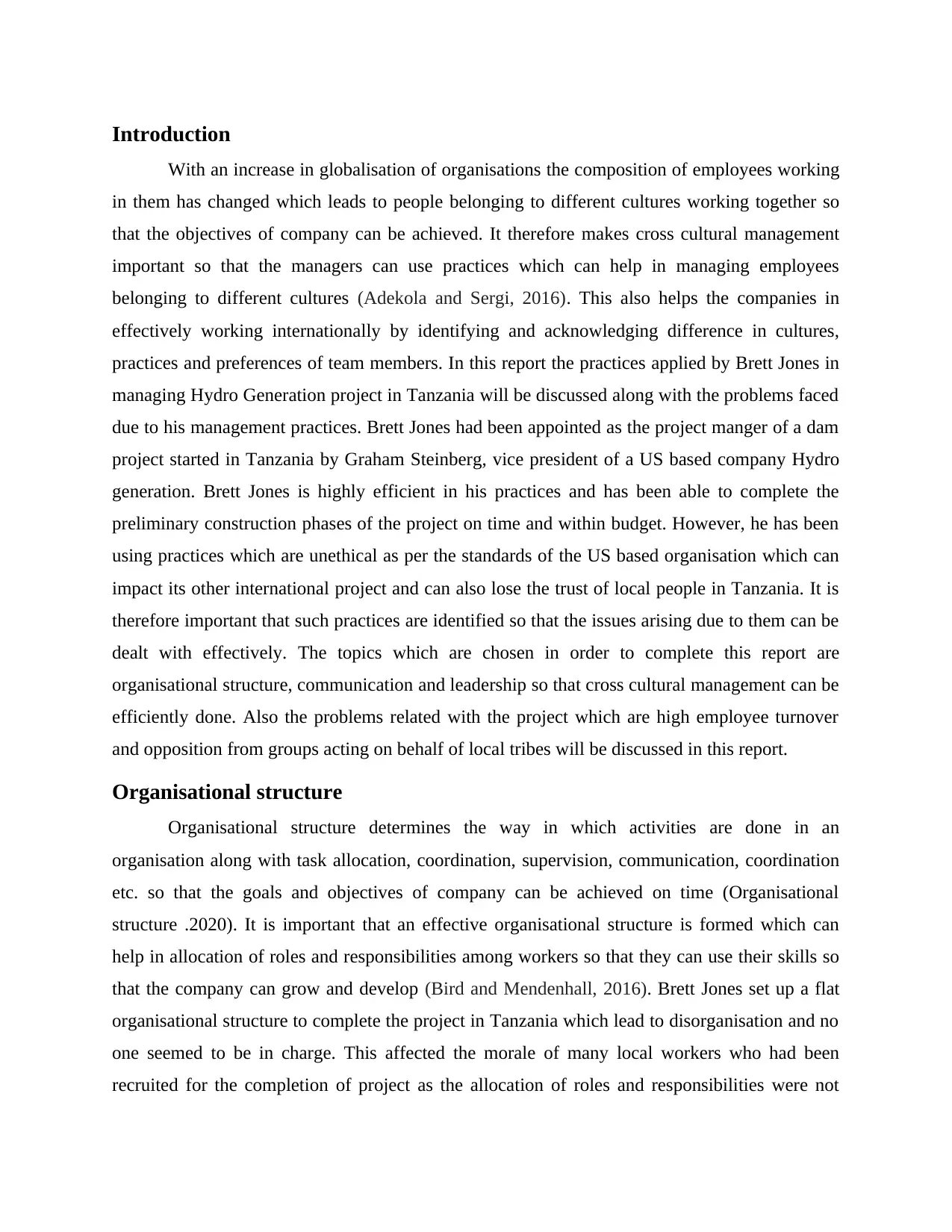
Introduction
With an increase in globalisation of organisations the composition of employees working
in them has changed which leads to people belonging to different cultures working together so
that the objectives of company can be achieved. It therefore makes cross cultural management
important so that the managers can use practices which can help in managing employees
belonging to different cultures (Adekola and Sergi, 2016). This also helps the companies in
effectively working internationally by identifying and acknowledging difference in cultures,
practices and preferences of team members. In this report the practices applied by Brett Jones in
managing Hydro Generation project in Tanzania will be discussed along with the problems faced
due to his management practices. Brett Jones had been appointed as the project manger of a dam
project started in Tanzania by Graham Steinberg, vice president of a US based company Hydro
generation. Brett Jones is highly efficient in his practices and has been able to complete the
preliminary construction phases of the project on time and within budget. However, he has been
using practices which are unethical as per the standards of the US based organisation which can
impact its other international project and can also lose the trust of local people in Tanzania. It is
therefore important that such practices are identified so that the issues arising due to them can be
dealt with effectively. The topics which are chosen in order to complete this report are
organisational structure, communication and leadership so that cross cultural management can be
efficiently done. Also the problems related with the project which are high employee turnover
and opposition from groups acting on behalf of local tribes will be discussed in this report.
Organisational structure
Organisational structure determines the way in which activities are done in an
organisation along with task allocation, coordination, supervision, communication, coordination
etc. so that the goals and objectives of company can be achieved on time (Organisational
structure .2020). It is important that an effective organisational structure is formed which can
help in allocation of roles and responsibilities among workers so that they can use their skills so
that the company can grow and develop (Bird and Mendenhall, 2016). Brett Jones set up a flat
organisational structure to complete the project in Tanzania which lead to disorganisation and no
one seemed to be in charge. This affected the morale of many local workers who had been
recruited for the completion of project as the allocation of roles and responsibilities were not
With an increase in globalisation of organisations the composition of employees working
in them has changed which leads to people belonging to different cultures working together so
that the objectives of company can be achieved. It therefore makes cross cultural management
important so that the managers can use practices which can help in managing employees
belonging to different cultures (Adekola and Sergi, 2016). This also helps the companies in
effectively working internationally by identifying and acknowledging difference in cultures,
practices and preferences of team members. In this report the practices applied by Brett Jones in
managing Hydro Generation project in Tanzania will be discussed along with the problems faced
due to his management practices. Brett Jones had been appointed as the project manger of a dam
project started in Tanzania by Graham Steinberg, vice president of a US based company Hydro
generation. Brett Jones is highly efficient in his practices and has been able to complete the
preliminary construction phases of the project on time and within budget. However, he has been
using practices which are unethical as per the standards of the US based organisation which can
impact its other international project and can also lose the trust of local people in Tanzania. It is
therefore important that such practices are identified so that the issues arising due to them can be
dealt with effectively. The topics which are chosen in order to complete this report are
organisational structure, communication and leadership so that cross cultural management can be
efficiently done. Also the problems related with the project which are high employee turnover
and opposition from groups acting on behalf of local tribes will be discussed in this report.
Organisational structure
Organisational structure determines the way in which activities are done in an
organisation along with task allocation, coordination, supervision, communication, coordination
etc. so that the goals and objectives of company can be achieved on time (Organisational
structure .2020). It is important that an effective organisational structure is formed which can
help in allocation of roles and responsibilities among workers so that they can use their skills so
that the company can grow and develop (Bird and Mendenhall, 2016). Brett Jones set up a flat
organisational structure to complete the project in Tanzania which lead to disorganisation and no
one seemed to be in charge. This affected the morale of many local workers who had been
recruited for the completion of project as the allocation of roles and responsibilities were not
⊘ This is a preview!⊘
Do you want full access?
Subscribe today to unlock all pages.

Trusted by 1+ million students worldwide
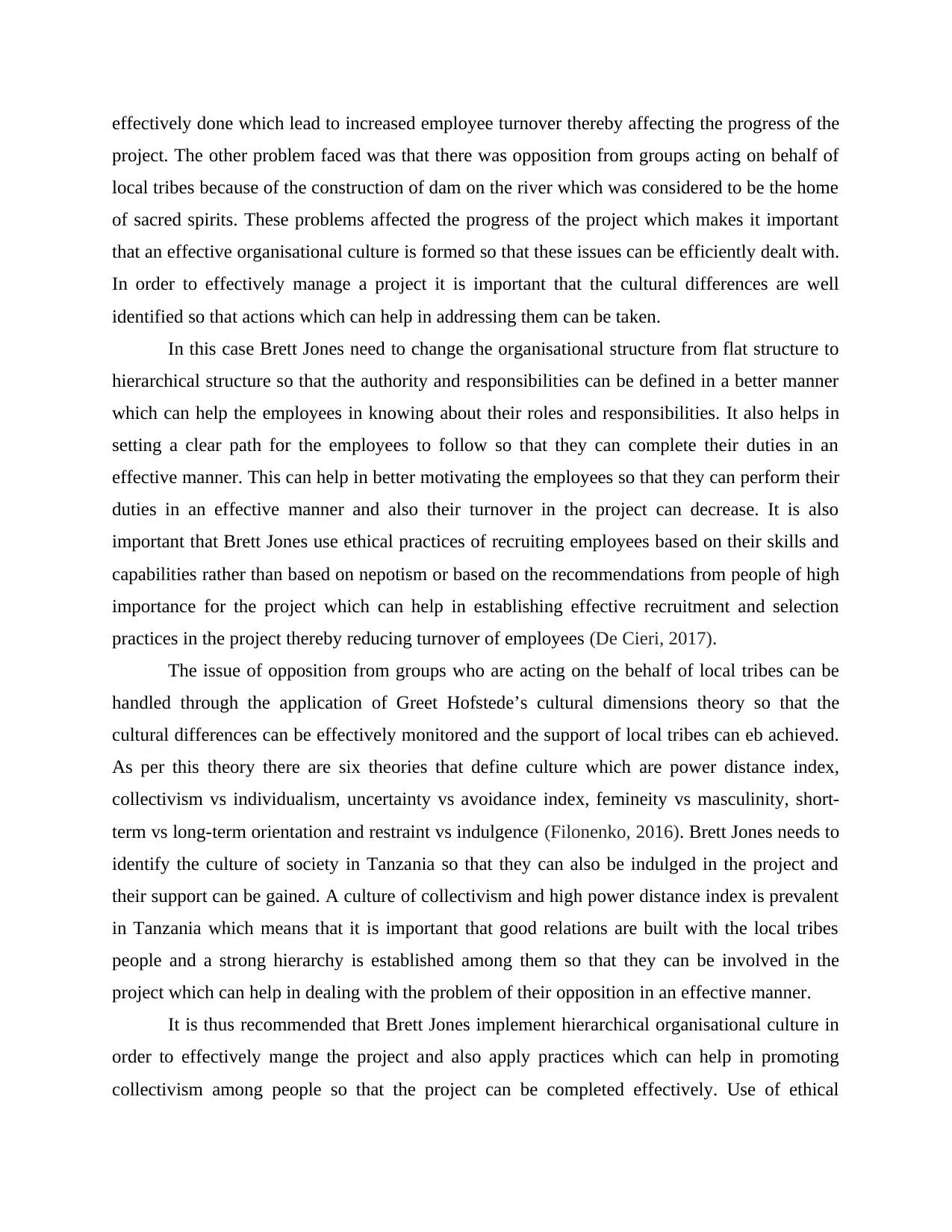
effectively done which lead to increased employee turnover thereby affecting the progress of the
project. The other problem faced was that there was opposition from groups acting on behalf of
local tribes because of the construction of dam on the river which was considered to be the home
of sacred spirits. These problems affected the progress of the project which makes it important
that an effective organisational culture is formed so that these issues can be efficiently dealt with.
In order to effectively manage a project it is important that the cultural differences are well
identified so that actions which can help in addressing them can be taken.
In this case Brett Jones need to change the organisational structure from flat structure to
hierarchical structure so that the authority and responsibilities can be defined in a better manner
which can help the employees in knowing about their roles and responsibilities. It also helps in
setting a clear path for the employees to follow so that they can complete their duties in an
effective manner. This can help in better motivating the employees so that they can perform their
duties in an effective manner and also their turnover in the project can decrease. It is also
important that Brett Jones use ethical practices of recruiting employees based on their skills and
capabilities rather than based on nepotism or based on the recommendations from people of high
importance for the project which can help in establishing effective recruitment and selection
practices in the project thereby reducing turnover of employees (De Cieri, 2017).
The issue of opposition from groups who are acting on the behalf of local tribes can be
handled through the application of Greet Hofstede’s cultural dimensions theory so that the
cultural differences can be effectively monitored and the support of local tribes can eb achieved.
As per this theory there are six theories that define culture which are power distance index,
collectivism vs individualism, uncertainty vs avoidance index, femineity vs masculinity, short-
term vs long-term orientation and restraint vs indulgence (Filonenko, 2016). Brett Jones needs to
identify the culture of society in Tanzania so that they can also be indulged in the project and
their support can be gained. A culture of collectivism and high power distance index is prevalent
in Tanzania which means that it is important that good relations are built with the local tribes
people and a strong hierarchy is established among them so that they can be involved in the
project which can help in dealing with the problem of their opposition in an effective manner.
It is thus recommended that Brett Jones implement hierarchical organisational culture in
order to effectively mange the project and also apply practices which can help in promoting
collectivism among people so that the project can be completed effectively. Use of ethical
project. The other problem faced was that there was opposition from groups acting on behalf of
local tribes because of the construction of dam on the river which was considered to be the home
of sacred spirits. These problems affected the progress of the project which makes it important
that an effective organisational culture is formed so that these issues can be efficiently dealt with.
In order to effectively manage a project it is important that the cultural differences are well
identified so that actions which can help in addressing them can be taken.
In this case Brett Jones need to change the organisational structure from flat structure to
hierarchical structure so that the authority and responsibilities can be defined in a better manner
which can help the employees in knowing about their roles and responsibilities. It also helps in
setting a clear path for the employees to follow so that they can complete their duties in an
effective manner. This can help in better motivating the employees so that they can perform their
duties in an effective manner and also their turnover in the project can decrease. It is also
important that Brett Jones use ethical practices of recruiting employees based on their skills and
capabilities rather than based on nepotism or based on the recommendations from people of high
importance for the project which can help in establishing effective recruitment and selection
practices in the project thereby reducing turnover of employees (De Cieri, 2017).
The issue of opposition from groups who are acting on the behalf of local tribes can be
handled through the application of Greet Hofstede’s cultural dimensions theory so that the
cultural differences can be effectively monitored and the support of local tribes can eb achieved.
As per this theory there are six theories that define culture which are power distance index,
collectivism vs individualism, uncertainty vs avoidance index, femineity vs masculinity, short-
term vs long-term orientation and restraint vs indulgence (Filonenko, 2016). Brett Jones needs to
identify the culture of society in Tanzania so that they can also be indulged in the project and
their support can be gained. A culture of collectivism and high power distance index is prevalent
in Tanzania which means that it is important that good relations are built with the local tribes
people and a strong hierarchy is established among them so that they can be involved in the
project which can help in dealing with the problem of their opposition in an effective manner.
It is thus recommended that Brett Jones implement hierarchical organisational culture in
order to effectively mange the project and also apply practices which can help in promoting
collectivism among people so that the project can be completed effectively. Use of ethical
Paraphrase This Document
Need a fresh take? Get an instant paraphrase of this document with our AI Paraphraser
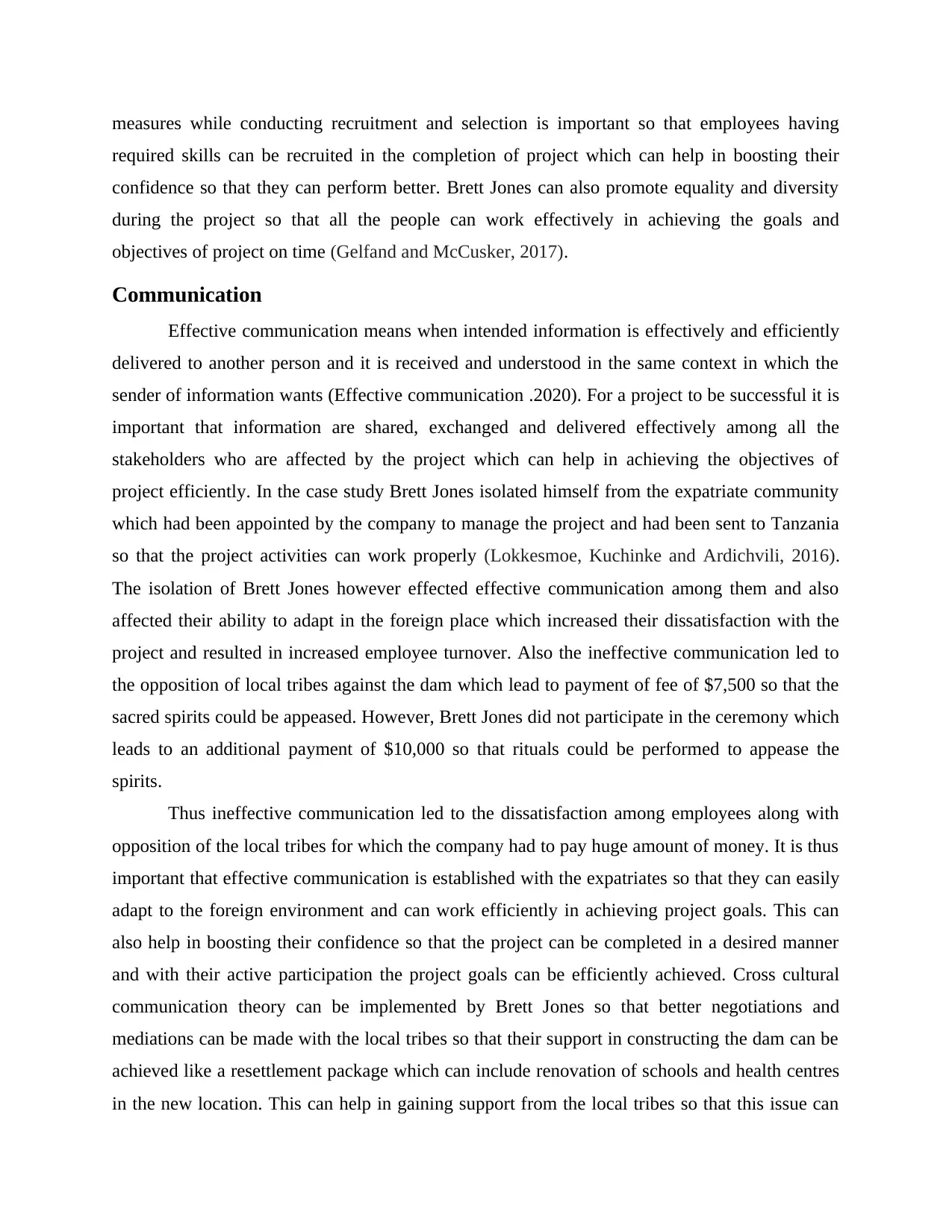
measures while conducting recruitment and selection is important so that employees having
required skills can be recruited in the completion of project which can help in boosting their
confidence so that they can perform better. Brett Jones can also promote equality and diversity
during the project so that all the people can work effectively in achieving the goals and
objectives of project on time (Gelfand and McCusker, 2017).
Communication
Effective communication means when intended information is effectively and efficiently
delivered to another person and it is received and understood in the same context in which the
sender of information wants (Effective communication .2020). For a project to be successful it is
important that information are shared, exchanged and delivered effectively among all the
stakeholders who are affected by the project which can help in achieving the objectives of
project efficiently. In the case study Brett Jones isolated himself from the expatriate community
which had been appointed by the company to manage the project and had been sent to Tanzania
so that the project activities can work properly (Lokkesmoe, Kuchinke and Ardichvili, 2016).
The isolation of Brett Jones however effected effective communication among them and also
affected their ability to adapt in the foreign place which increased their dissatisfaction with the
project and resulted in increased employee turnover. Also the ineffective communication led to
the opposition of local tribes against the dam which lead to payment of fee of $7,500 so that the
sacred spirits could be appeased. However, Brett Jones did not participate in the ceremony which
leads to an additional payment of $10,000 so that rituals could be performed to appease the
spirits.
Thus ineffective communication led to the dissatisfaction among employees along with
opposition of the local tribes for which the company had to pay huge amount of money. It is thus
important that effective communication is established with the expatriates so that they can easily
adapt to the foreign environment and can work efficiently in achieving project goals. This can
also help in boosting their confidence so that the project can be completed in a desired manner
and with their active participation the project goals can be efficiently achieved. Cross cultural
communication theory can be implemented by Brett Jones so that better negotiations and
mediations can be made with the local tribes so that their support in constructing the dam can be
achieved like a resettlement package which can include renovation of schools and health centres
in the new location. This can help in gaining support from the local tribes so that this issue can
required skills can be recruited in the completion of project which can help in boosting their
confidence so that they can perform better. Brett Jones can also promote equality and diversity
during the project so that all the people can work effectively in achieving the goals and
objectives of project on time (Gelfand and McCusker, 2017).
Communication
Effective communication means when intended information is effectively and efficiently
delivered to another person and it is received and understood in the same context in which the
sender of information wants (Effective communication .2020). For a project to be successful it is
important that information are shared, exchanged and delivered effectively among all the
stakeholders who are affected by the project which can help in achieving the objectives of
project efficiently. In the case study Brett Jones isolated himself from the expatriate community
which had been appointed by the company to manage the project and had been sent to Tanzania
so that the project activities can work properly (Lokkesmoe, Kuchinke and Ardichvili, 2016).
The isolation of Brett Jones however effected effective communication among them and also
affected their ability to adapt in the foreign place which increased their dissatisfaction with the
project and resulted in increased employee turnover. Also the ineffective communication led to
the opposition of local tribes against the dam which lead to payment of fee of $7,500 so that the
sacred spirits could be appeased. However, Brett Jones did not participate in the ceremony which
leads to an additional payment of $10,000 so that rituals could be performed to appease the
spirits.
Thus ineffective communication led to the dissatisfaction among employees along with
opposition of the local tribes for which the company had to pay huge amount of money. It is thus
important that effective communication is established with the expatriates so that they can easily
adapt to the foreign environment and can work efficiently in achieving project goals. This can
also help in boosting their confidence so that the project can be completed in a desired manner
and with their active participation the project goals can be efficiently achieved. Cross cultural
communication theory can be implemented by Brett Jones so that better negotiations and
mediations can be made with the local tribes so that their support in constructing the dam can be
achieved like a resettlement package which can include renovation of schools and health centres
in the new location. This can help in gaining support from the local tribes so that this issue can
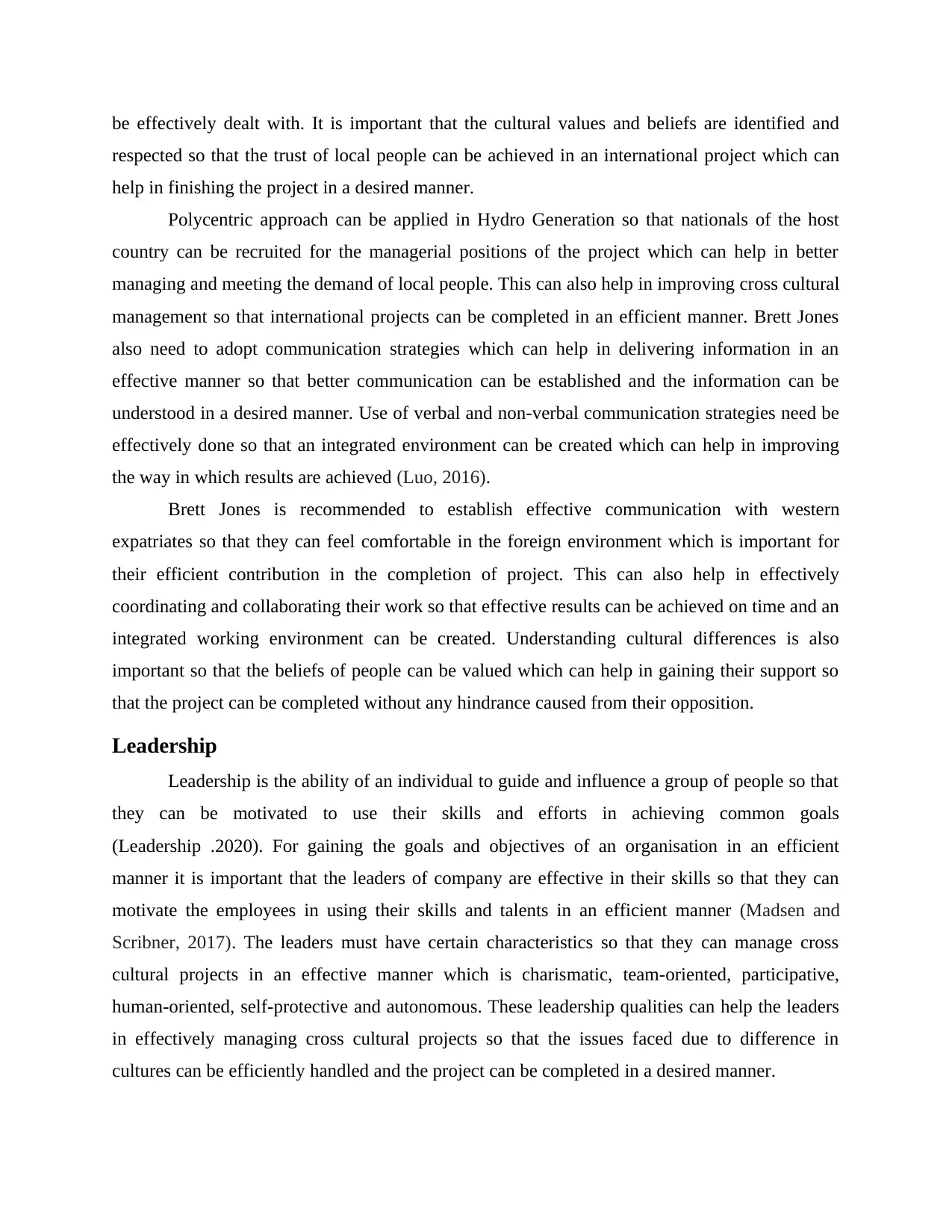
be effectively dealt with. It is important that the cultural values and beliefs are identified and
respected so that the trust of local people can be achieved in an international project which can
help in finishing the project in a desired manner.
Polycentric approach can be applied in Hydro Generation so that nationals of the host
country can be recruited for the managerial positions of the project which can help in better
managing and meeting the demand of local people. This can also help in improving cross cultural
management so that international projects can be completed in an efficient manner. Brett Jones
also need to adopt communication strategies which can help in delivering information in an
effective manner so that better communication can be established and the information can be
understood in a desired manner. Use of verbal and non-verbal communication strategies need be
effectively done so that an integrated environment can be created which can help in improving
the way in which results are achieved (Luo, 2016).
Brett Jones is recommended to establish effective communication with western
expatriates so that they can feel comfortable in the foreign environment which is important for
their efficient contribution in the completion of project. This can also help in effectively
coordinating and collaborating their work so that effective results can be achieved on time and an
integrated working environment can be created. Understanding cultural differences is also
important so that the beliefs of people can be valued which can help in gaining their support so
that the project can be completed without any hindrance caused from their opposition.
Leadership
Leadership is the ability of an individual to guide and influence a group of people so that
they can be motivated to use their skills and efforts in achieving common goals
(Leadership .2020). For gaining the goals and objectives of an organisation in an efficient
manner it is important that the leaders of company are effective in their skills so that they can
motivate the employees in using their skills and talents in an efficient manner (Madsen and
Scribner, 2017). The leaders must have certain characteristics so that they can manage cross
cultural projects in an effective manner which is charismatic, team-oriented, participative,
human-oriented, self-protective and autonomous. These leadership qualities can help the leaders
in effectively managing cross cultural projects so that the issues faced due to difference in
cultures can be efficiently handled and the project can be completed in a desired manner.
respected so that the trust of local people can be achieved in an international project which can
help in finishing the project in a desired manner.
Polycentric approach can be applied in Hydro Generation so that nationals of the host
country can be recruited for the managerial positions of the project which can help in better
managing and meeting the demand of local people. This can also help in improving cross cultural
management so that international projects can be completed in an efficient manner. Brett Jones
also need to adopt communication strategies which can help in delivering information in an
effective manner so that better communication can be established and the information can be
understood in a desired manner. Use of verbal and non-verbal communication strategies need be
effectively done so that an integrated environment can be created which can help in improving
the way in which results are achieved (Luo, 2016).
Brett Jones is recommended to establish effective communication with western
expatriates so that they can feel comfortable in the foreign environment which is important for
their efficient contribution in the completion of project. This can also help in effectively
coordinating and collaborating their work so that effective results can be achieved on time and an
integrated working environment can be created. Understanding cultural differences is also
important so that the beliefs of people can be valued which can help in gaining their support so
that the project can be completed without any hindrance caused from their opposition.
Leadership
Leadership is the ability of an individual to guide and influence a group of people so that
they can be motivated to use their skills and efforts in achieving common goals
(Leadership .2020). For gaining the goals and objectives of an organisation in an efficient
manner it is important that the leaders of company are effective in their skills so that they can
motivate the employees in using their skills and talents in an efficient manner (Madsen and
Scribner, 2017). The leaders must have certain characteristics so that they can manage cross
cultural projects in an effective manner which is charismatic, team-oriented, participative,
human-oriented, self-protective and autonomous. These leadership qualities can help the leaders
in effectively managing cross cultural projects so that the issues faced due to difference in
cultures can be efficiently handled and the project can be completed in a desired manner.
⊘ This is a preview!⊘
Do you want full access?
Subscribe today to unlock all pages.

Trusted by 1+ million students worldwide
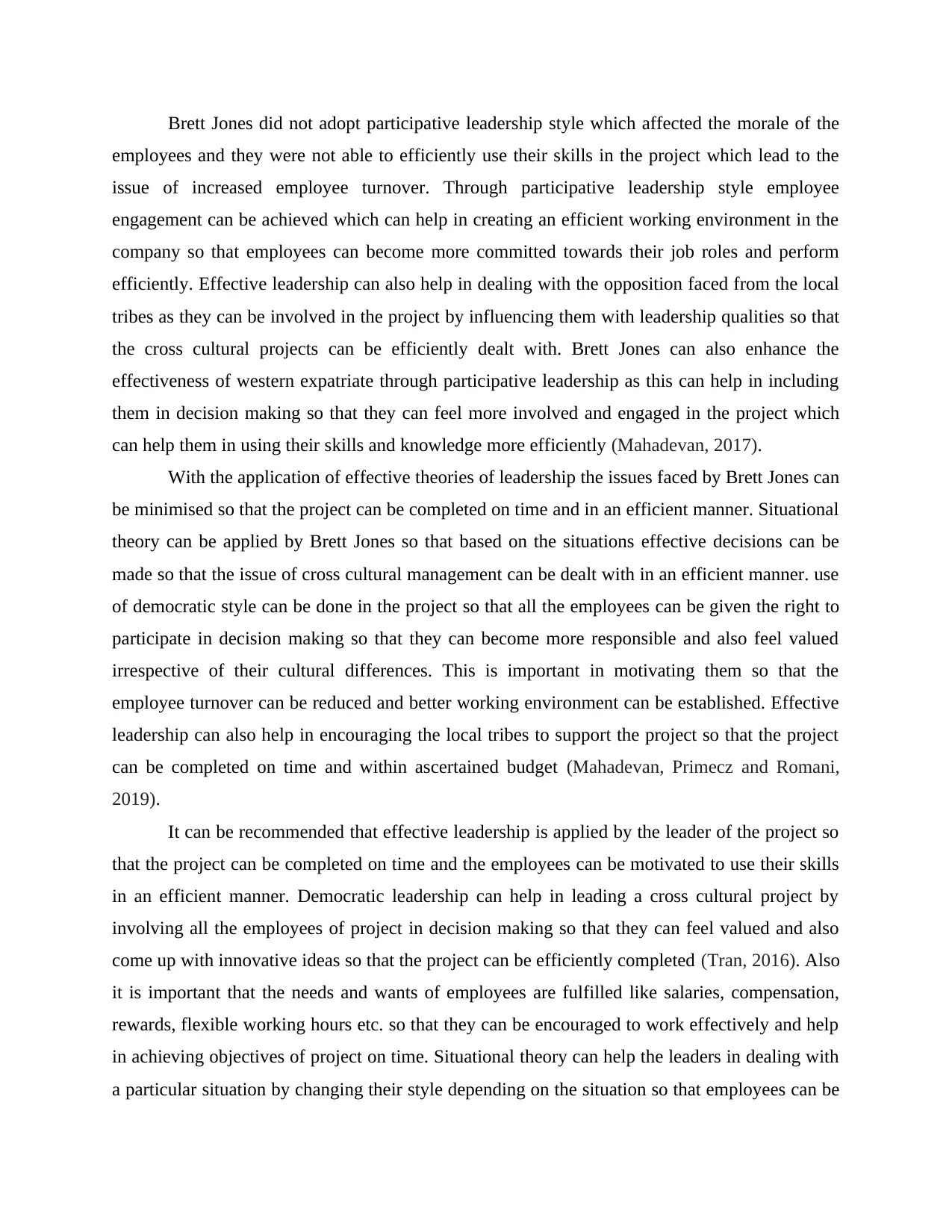
Brett Jones did not adopt participative leadership style which affected the morale of the
employees and they were not able to efficiently use their skills in the project which lead to the
issue of increased employee turnover. Through participative leadership style employee
engagement can be achieved which can help in creating an efficient working environment in the
company so that employees can become more committed towards their job roles and perform
efficiently. Effective leadership can also help in dealing with the opposition faced from the local
tribes as they can be involved in the project by influencing them with leadership qualities so that
the cross cultural projects can be efficiently dealt with. Brett Jones can also enhance the
effectiveness of western expatriate through participative leadership as this can help in including
them in decision making so that they can feel more involved and engaged in the project which
can help them in using their skills and knowledge more efficiently (Mahadevan, 2017).
With the application of effective theories of leadership the issues faced by Brett Jones can
be minimised so that the project can be completed on time and in an efficient manner. Situational
theory can be applied by Brett Jones so that based on the situations effective decisions can be
made so that the issue of cross cultural management can be dealt with in an efficient manner. use
of democratic style can be done in the project so that all the employees can be given the right to
participate in decision making so that they can become more responsible and also feel valued
irrespective of their cultural differences. This is important in motivating them so that the
employee turnover can be reduced and better working environment can be established. Effective
leadership can also help in encouraging the local tribes to support the project so that the project
can be completed on time and within ascertained budget (Mahadevan, Primecz and Romani,
2019).
It can be recommended that effective leadership is applied by the leader of the project so
that the project can be completed on time and the employees can be motivated to use their skills
in an efficient manner. Democratic leadership can help in leading a cross cultural project by
involving all the employees of project in decision making so that they can feel valued and also
come up with innovative ideas so that the project can be efficiently completed (Tran, 2016). Also
it is important that the needs and wants of employees are fulfilled like salaries, compensation,
rewards, flexible working hours etc. so that they can be encouraged to work effectively and help
in achieving objectives of project on time. Situational theory can help the leaders in dealing with
a particular situation by changing their style depending on the situation so that employees can be
employees and they were not able to efficiently use their skills in the project which lead to the
issue of increased employee turnover. Through participative leadership style employee
engagement can be achieved which can help in creating an efficient working environment in the
company so that employees can become more committed towards their job roles and perform
efficiently. Effective leadership can also help in dealing with the opposition faced from the local
tribes as they can be involved in the project by influencing them with leadership qualities so that
the cross cultural projects can be efficiently dealt with. Brett Jones can also enhance the
effectiveness of western expatriate through participative leadership as this can help in including
them in decision making so that they can feel more involved and engaged in the project which
can help them in using their skills and knowledge more efficiently (Mahadevan, 2017).
With the application of effective theories of leadership the issues faced by Brett Jones can
be minimised so that the project can be completed on time and in an efficient manner. Situational
theory can be applied by Brett Jones so that based on the situations effective decisions can be
made so that the issue of cross cultural management can be dealt with in an efficient manner. use
of democratic style can be done in the project so that all the employees can be given the right to
participate in decision making so that they can become more responsible and also feel valued
irrespective of their cultural differences. This is important in motivating them so that the
employee turnover can be reduced and better working environment can be established. Effective
leadership can also help in encouraging the local tribes to support the project so that the project
can be completed on time and within ascertained budget (Mahadevan, Primecz and Romani,
2019).
It can be recommended that effective leadership is applied by the leader of the project so
that the project can be completed on time and the employees can be motivated to use their skills
in an efficient manner. Democratic leadership can help in leading a cross cultural project by
involving all the employees of project in decision making so that they can feel valued and also
come up with innovative ideas so that the project can be efficiently completed (Tran, 2016). Also
it is important that the needs and wants of employees are fulfilled like salaries, compensation,
rewards, flexible working hours etc. so that they can be encouraged to work effectively and help
in achieving objectives of project on time. Situational theory can help the leaders in dealing with
a particular situation by changing their style depending on the situation so that employees can be
Paraphrase This Document
Need a fresh take? Get an instant paraphrase of this document with our AI Paraphraser
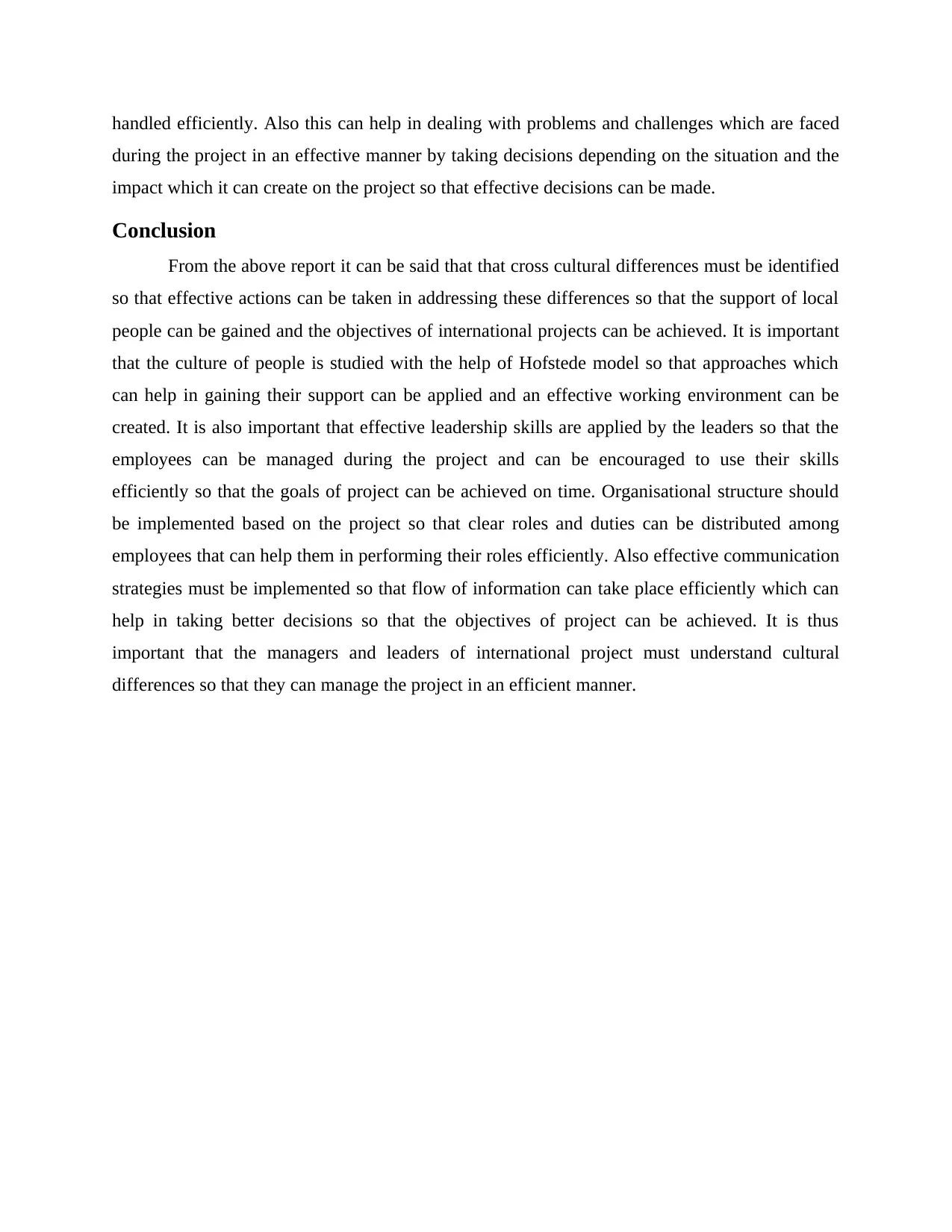
handled efficiently. Also this can help in dealing with problems and challenges which are faced
during the project in an effective manner by taking decisions depending on the situation and the
impact which it can create on the project so that effective decisions can be made.
Conclusion
From the above report it can be said that that cross cultural differences must be identified
so that effective actions can be taken in addressing these differences so that the support of local
people can be gained and the objectives of international projects can be achieved. It is important
that the culture of people is studied with the help of Hofstede model so that approaches which
can help in gaining their support can be applied and an effective working environment can be
created. It is also important that effective leadership skills are applied by the leaders so that the
employees can be managed during the project and can be encouraged to use their skills
efficiently so that the goals of project can be achieved on time. Organisational structure should
be implemented based on the project so that clear roles and duties can be distributed among
employees that can help them in performing their roles efficiently. Also effective communication
strategies must be implemented so that flow of information can take place efficiently which can
help in taking better decisions so that the objectives of project can be achieved. It is thus
important that the managers and leaders of international project must understand cultural
differences so that they can manage the project in an efficient manner.
during the project in an effective manner by taking decisions depending on the situation and the
impact which it can create on the project so that effective decisions can be made.
Conclusion
From the above report it can be said that that cross cultural differences must be identified
so that effective actions can be taken in addressing these differences so that the support of local
people can be gained and the objectives of international projects can be achieved. It is important
that the culture of people is studied with the help of Hofstede model so that approaches which
can help in gaining their support can be applied and an effective working environment can be
created. It is also important that effective leadership skills are applied by the leaders so that the
employees can be managed during the project and can be encouraged to use their skills
efficiently so that the goals of project can be achieved on time. Organisational structure should
be implemented based on the project so that clear roles and duties can be distributed among
employees that can help them in performing their roles efficiently. Also effective communication
strategies must be implemented so that flow of information can take place efficiently which can
help in taking better decisions so that the objectives of project can be achieved. It is thus
important that the managers and leaders of international project must understand cultural
differences so that they can manage the project in an efficient manner.
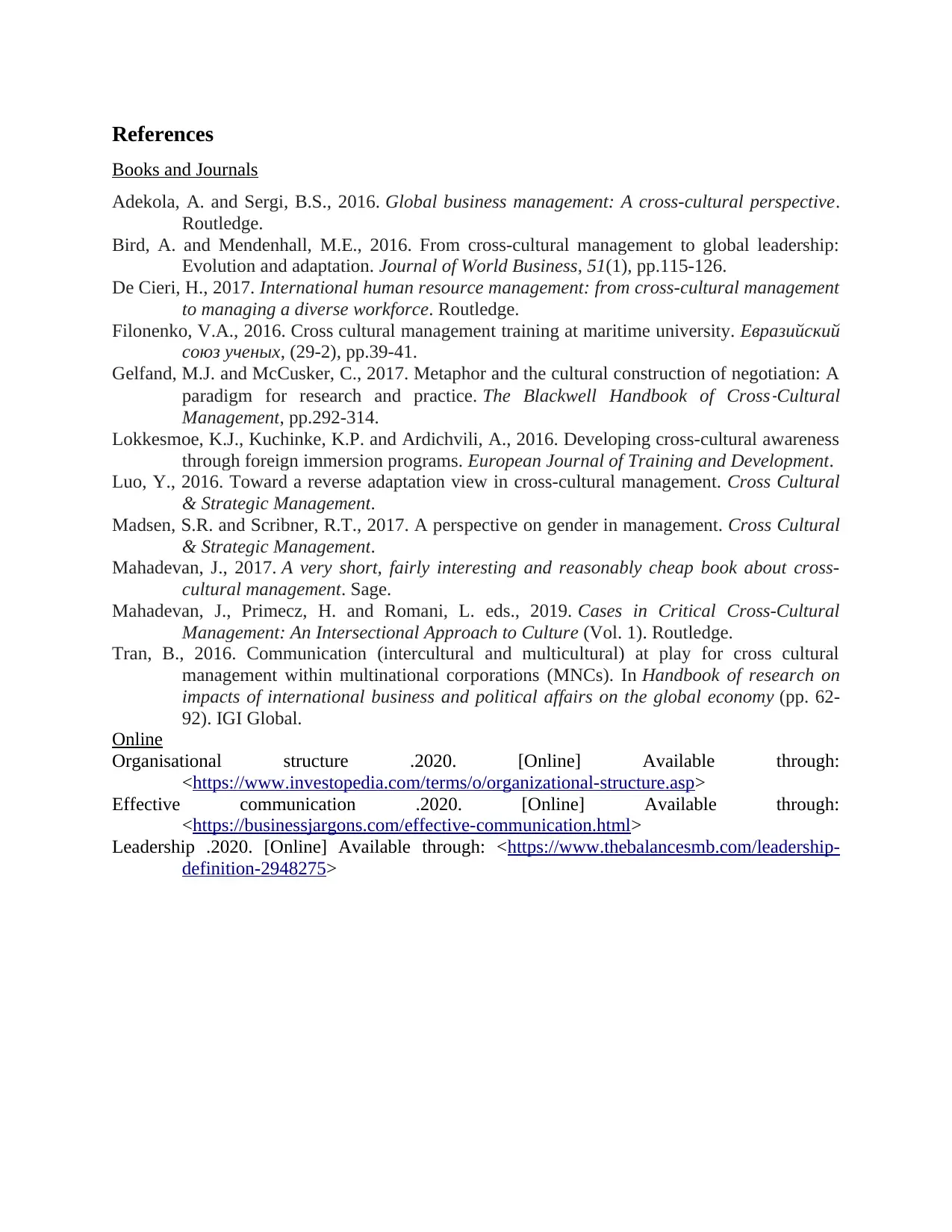
References
Books and Journals
Adekola, A. and Sergi, B.S., 2016. Global business management: A cross-cultural perspective.
Routledge.
Bird, A. and Mendenhall, M.E., 2016. From cross-cultural management to global leadership:
Evolution and adaptation. Journal of World Business, 51(1), pp.115-126.
De Cieri, H., 2017. International human resource management: from cross-cultural management
to managing a diverse workforce. Routledge.
Filonenko, V.A., 2016. Cross cultural management training at maritime university. Евразийский
союз ученых, (29-2), pp.39-41.
Gelfand, M.J. and McCusker, C., 2017. Metaphor and the cultural construction of negotiation: A
paradigm for research and practice. The Blackwell Handbook of Cross
‐Cultural
Management, pp.292-314.
Lokkesmoe, K.J., Kuchinke, K.P. and Ardichvili, A., 2016. Developing cross-cultural awareness
through foreign immersion programs. European Journal of Training and Development.
Luo, Y., 2016. Toward a reverse adaptation view in cross-cultural management. Cross Cultural
& Strategic Management.
Madsen, S.R. and Scribner, R.T., 2017. A perspective on gender in management. Cross Cultural
& Strategic Management.
Mahadevan, J., 2017. A very short, fairly interesting and reasonably cheap book about cross-
cultural management. Sage.
Mahadevan, J., Primecz, H. and Romani, L. eds., 2019. Cases in Critical Cross-Cultural
Management: An Intersectional Approach to Culture (Vol. 1). Routledge.
Tran, B., 2016. Communication (intercultural and multicultural) at play for cross cultural
management within multinational corporations (MNCs). In Handbook of research on
impacts of international business and political affairs on the global economy (pp. 62-
92). IGI Global.
Online
Organisational structure .2020. [Online] Available through:
<https://www.investopedia.com/terms/o/organizational-structure.asp>
Effective communication .2020. [Online] Available through:
<https://businessjargons.com/effective-communication.html>
Leadership .2020. [Online] Available through: <https://www.thebalancesmb.com/leadership-
definition-2948275>
Books and Journals
Adekola, A. and Sergi, B.S., 2016. Global business management: A cross-cultural perspective.
Routledge.
Bird, A. and Mendenhall, M.E., 2016. From cross-cultural management to global leadership:
Evolution and adaptation. Journal of World Business, 51(1), pp.115-126.
De Cieri, H., 2017. International human resource management: from cross-cultural management
to managing a diverse workforce. Routledge.
Filonenko, V.A., 2016. Cross cultural management training at maritime university. Евразийский
союз ученых, (29-2), pp.39-41.
Gelfand, M.J. and McCusker, C., 2017. Metaphor and the cultural construction of negotiation: A
paradigm for research and practice. The Blackwell Handbook of Cross
‐Cultural
Management, pp.292-314.
Lokkesmoe, K.J., Kuchinke, K.P. and Ardichvili, A., 2016. Developing cross-cultural awareness
through foreign immersion programs. European Journal of Training and Development.
Luo, Y., 2016. Toward a reverse adaptation view in cross-cultural management. Cross Cultural
& Strategic Management.
Madsen, S.R. and Scribner, R.T., 2017. A perspective on gender in management. Cross Cultural
& Strategic Management.
Mahadevan, J., 2017. A very short, fairly interesting and reasonably cheap book about cross-
cultural management. Sage.
Mahadevan, J., Primecz, H. and Romani, L. eds., 2019. Cases in Critical Cross-Cultural
Management: An Intersectional Approach to Culture (Vol. 1). Routledge.
Tran, B., 2016. Communication (intercultural and multicultural) at play for cross cultural
management within multinational corporations (MNCs). In Handbook of research on
impacts of international business and political affairs on the global economy (pp. 62-
92). IGI Global.
Online
Organisational structure .2020. [Online] Available through:
<https://www.investopedia.com/terms/o/organizational-structure.asp>
Effective communication .2020. [Online] Available through:
<https://businessjargons.com/effective-communication.html>
Leadership .2020. [Online] Available through: <https://www.thebalancesmb.com/leadership-
definition-2948275>
⊘ This is a preview!⊘
Do you want full access?
Subscribe today to unlock all pages.

Trusted by 1+ million students worldwide
1 out of 9
Related Documents
Your All-in-One AI-Powered Toolkit for Academic Success.
+13062052269
info@desklib.com
Available 24*7 on WhatsApp / Email
![[object Object]](/_next/static/media/star-bottom.7253800d.svg)
Unlock your academic potential
Copyright © 2020–2025 A2Z Services. All Rights Reserved. Developed and managed by ZUCOL.




